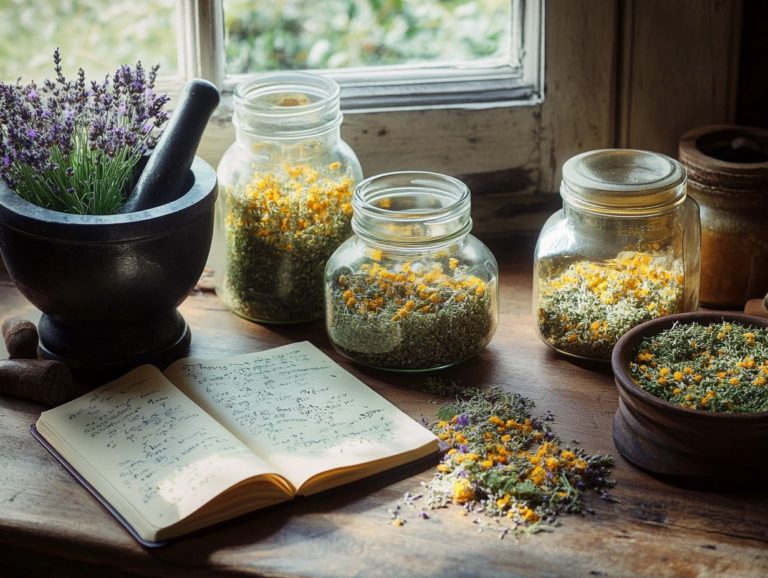How to Create Herbal Skin Treatments at Home
Are you tired of skincare products filled with chemicals that make big promises but often fail? Herbal skincare can be a wonderful alternative.
Herbal skin treatments might be the natural solution you’ve been looking for. This article explores the benefits of incorporating herbal remedies into your skincare routine, highlighting popular herbs such as chamomile, lavender, and calendula.
Learn how to create your own herbal treatments at home. This ensures safety and effectiveness while embracing the principles of herbalism. Embrace the nurturing power of nature for your skin!
Contents
- Key Takeaways:
- Benefits of Using Herbal Skin Treatments
- Common Herbs Used in Skin Treatments
- Creating Herbal Skin Treatments at Home
- Safety Considerations
- Frequently Asked Questions
- What are the benefits of creating herbal skin treatments at home?
- What are some common ingredients used in herbal skin treatments?
- How can I determine which herbal ingredients are best for my skin?
- Can I combine different herbal ingredients in one skin treatment?
- How do I create a basic herbal skin treatment at home?
- Are there any precautions I should take when creating herbal skin treatments at home?
Key Takeaways:

- Herbal skin treatments offer natural ingredients known for their benefits, making them essential in any beauty routine.
- Common herbs provide soothing and healing properties, enhancing skincare results.
- It’s easy and cost-effective to create herbal treatments at home with simple ingredients like almond oil and honey.
What are Herbal Skin Treatments?
Herbal skin treatments offer a holistic approach to skincare based on nature’s healing properties. Ancient civilizations, including the Egyptians and Greeks, relied on herbal remedies for beauty and skin health.
Imagine using natural ingredients like chamomile, lavender, and calendula each one soothes and nourishes your skin.
These herbal practices were part of cultural rituals and traditional medicine, offering solutions for many skin issues. Over time, the knowledge of these natural remedies spread as science explored their properties.
Today, skincare emphasizes the effectiveness of natural ingredients over synthetic ones. This reinforces the idea that the best nourishment for your skin comes from the earth.
This shift also highlights the effectiveness of herbs in beauty and celebrates the benefits of sustainable sourcing, making herbal skin treatments an enticing choice for the mindful consumer.
Benefits of Using Herbal Skin Treatments
Using herbal skin treatments offers many benefits that enhance your beauty while caring for your skin s health. These treatments harness the power of natural ingredients with therapeutic effects for various skin concerns, from aging to dryness.
By adding these natural solutions to your routine, you can enjoy healthier, rejuvenated skin free from harsh chemicals.
Natural Ingredients and Their Effects
Natural ingredients are crucial in herbal skin treatments, each offering unique benefits for your skin s needs. For instance, chamomile soothes irritation, while calendula has anti-inflammatory properties for healing.
Lavender not only smells delightful but also adds antiseptic benefits, making it valuable in skincare.
These herbal ingredients work well together to improve your skin’s appearance and health. Chamomile helps reduce redness and puffiness, creating a more even complexion. Calendula repairs damaged skin and speeds healing of minor cuts. Lavender s calming scent can also reduce stress-related breakouts.
These natural wonders form a strong foundation for achieving radiant skin.
Common Herbs Used in Skin Treatments

Several timeless herbs have proven themselves as essential allies in the realm of skin treatments, each offering distinct benefits.
Chamomile is renowned for its soothing qualities and is often used to reduce redness and irritation.
Lavender not only adds a fragrant touch but also acts as a natural antiseptic that aids in healing.
Calendula is prized for its anti-inflammatory and restorative properties, making it a staple in numerous herbal skincare products.
Properties and Uses of Popular Herbs
Popular herbs like chamomile, lavender, and calendula bring unique properties to your herbal skin treatments, whether in scrubs, masks, or oils.
Chamomile is perfect for calming sensitive skin with its anti-inflammatory and soothing qualities.
Lavender elevates your senses and aids in healing minor cuts and burns due to its antiseptic properties.
Calendula promotes skin regeneration and hydration, often finding a prominent place in beauty routines.
Don t overlook peppermint and aloe vera. Peppermint offers a refreshing, cooling sensation that soothes irritated skin and reduces redness.
Aloe vera is a hydration powerhouse, frequently included in gels and creams to provide moisture and enhance skin elasticity.
Blend these herbs into your topical treatments or infuse them in oils to craft customized skincare products that harness natural healing properties. Transform your skincare routine into a joyful ritual with these simple yet effective herbal treatments!
Creating Herbal Skin Treatments at Home
Creating herbal skin treatments at home allows you to harness nature s bounty to elevate your beauty routine.
By crafting your own products, you can ensure they are free from harmful chemicals and perfectly tailored to your unique skin needs.
Techniques such as blending oils with essential herbs or preparing herbal infusions (steeping herbs in water) can lead to effective treatments like soothing masks or nourishing lotions, making it a delightful endeavor for anyone eager to embrace the art of DIY skincare.
Step-by-Step Guide
This step-by-step guide will lead you through crafting effective herbal skin treatments, from nourishing oils to revitalizing masks.
Start by selecting your preferred herbs: calendula for its healing properties, chamomile for its soothing effects, and lavender for its aromatic qualities.
Prepare your herbs into an infusion or decoction, seamlessly blending these preparations with carrier oils like almond or coconut oil for enhanced benefits.
Once your herbs are primed, carefully measure your carrier oils to achieve the perfect balance.
Gently heat the oils to absorb the botanical essence without compromising their beneficial properties. This technique unlocks the healing compounds within the herbs and gives a luxurious texture to your skin treatments.
After the infusion, strain the mixture to remove any solid residue, preserving the rich, aromatic oil.
Consider enhancing your concoction with essential oils like tea tree or lavender for additional therapeutic benefits tailored to your unique skin concerns.
Safety Considerations

When exploring herbal skin treatments, safety should be your top priority to avoid potential allergic reactions and unwanted side effects.
Although many natural ingredients are gentle, some individuals may have sensitivities.
That s why performing a patch test before applying anything fully is essential.
By paying attention to your unique skin type and conducting preliminary tests, you can enjoy the benefits of herbal treatments while keeping your skin healthy and vibrant.
Start creating your own herbal treatments today and discover a radiant, healthy glow!
Potential Allergic Reactions and Precautions
Awareness of potential allergic reactions is essential when using herbal skin treatments. Even the most natural ingredients can provoke sensitivity in some individuals. Before you apply any new product, consider conducting a patch test this involves applying a small amount of product to your skin to check for reactions. This simple step can help you identify any adverse reactions, allowing you to enjoy the therapeutic benefits of herbal remedies while minimizing the risk of irritation or discomfort.
Along with patch testing, it s important to remember that everyone’s skin is unique. Some individuals possess heightened sensitivities to specific herbs or essential oils. Researching the ingredients in any herbal product can provide valuable insights into common allergens. Consulting a dermatologist or skincare professional can also offer tailored advice, especially if you have any pre-existing skin conditions.
Keeping a journal of your reactions might also be a wise move. This enables you to track sensitivities over time. By taking these precautions, you can safely explore the wonderful world of herbal skin care, ultimately enhancing your wellness journey.
Incorporating Herbal Skin Treatments into Your Skincare Routine
Incorporating herbal skin treatments into your skincare routine elevates your beauty regimen. They offer both nourishing and therapeutic benefits. By integrating natural ingredients like soothing oils and infusions, you can effectively tackle various skin concerns while promoting overall health.
Whether you opt for a gentle chamomile rinse or a hydrating lavender lotion, these treatments work to maintain moisture and support the vitality of your skin. You might also consider crafting your own herbal remedies at home for additional skin benefits.
Tips for Maximum Effectiveness
To unlock the full potential of your herbal skin treatments, consider these essential tips designed to elevate your skincare experience. Begin by selecting high-quality, fresh ingredients that are rich in nutrients and therapeutic benefits. Remember, consistency is your best ally; regularly applying your herbal treatments will help you establish a solid skincare routine that yields visible results over time.
Incorporating a variety of herbs with specific properties such as chamomile for its soothing effects or tea tree oil for its antibacterial benefits can significantly enhance your outcomes. It’s equally important to be mindful of each ingredient’s potency; overusing powerful extracts may cause irritation. Always start with a patch test. For those interested in making your own blends, following these simple steps to create herbal-infused oils allows you to tailor the frequency of your applications based on your skin’s responses, ensuring that your treatments work in harmony with your skin’s natural rhythms.
Consider integrating your herbal treatments with other natural practices, such as staying hydrated and maintaining proper nutrition, to further support your overall skin health. To enhance your herbal regimen, check out homemade herbal salves for added benefits.
Frequently Asked Questions

What are the benefits of creating herbal skin treatments at home?
Making herbal skin treatments at home lets you tailor products to your unique needs. You can use safe, natural ingredients and save money compared to store-bought products.
What are some common ingredients used in herbal skin treatments?
Common ingredients include aloe vera, coconut oil, honey, essential oils, and various herbs such as chamomile, lavender, and calendula.
How can I determine which herbal ingredients are best for my skin?
Research each ingredient s properties and consider your skin type and specific concerns to choose the most suitable ingredients.
Can I combine different herbal ingredients in one skin treatment?
Absolutely! Combining different herbal ingredients can create a synergistic effect and enhance the benefits of each ingredient. Just make sure to properly research and test the ingredients before using them together.
How do I create a basic herbal skin treatment at home?
A basic herbal skin treatment can be made by mixing a carrier oil with a few drops of essential oil and applying it to your skin. You can also create herbal infusions or toners by steeping herbs in hot water and using the liquid on your skin.
Are there any precautions I should take when creating herbal skin treatments at home?
Yes, it’s crucial to research and test all ingredients before using them on your skin. Be aware of any allergies or sensitivities you might have to certain herbs or essential oils.
If you’re unsure, it s a good idea to talk to a herbal expert or skin doctor. Taking these steps can help you enjoy a safe and effective herbal treatment!






